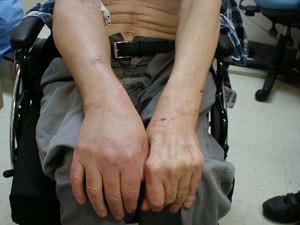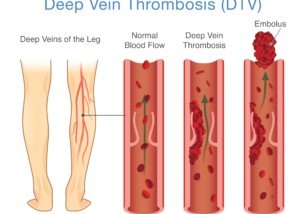
Yes, a deep vein thrombosis can occur in the arm, not just in the legs.
The risk factors for a DVT occurring in an arm are the same as for the leg — generally speaking.
But there’s a subset of risks that are much more applicable to blood clot formation in an arm.
Symptoms of an Arm DVT
• Swelling of the arm as the blood builds up, since the blood can’t get past the clot.
• Pain or tenderness in the arm, caused by tissue damage.
• Red or purplish color to the skin.
• Arm feels warm, due to irritated blood vessels.
• Bulging veins (when previously they weren’t).
• Hand weakness
• You won’t necessarily have every one of these symptoms and sometimes may not have any symptoms at all.
• Typically only one arm is affected.
DVT Risk Factors
“DVT, or deep venous thrombosis, is the process of blood clotting in any large veins, which is abnormal,” says Morton Tavel, MD, Clinical Professor Emeritus of Medicine, Indiana University School of Medicine, and author of “Health Tips, Myths and Tricks: A Physician’s Advice.”
“Anything that slows the venous flow excessively, such as heart failure or prolonged sitting, motionless standing or the presence of dilated (varicose) veins, will increase the likelihood of clotting,” continues Dr. Tavel.
Additional risk factors are uninterrupted long periods cramped in a seat during long air or road travel, obesity, smoking, birth control pills and joint replacement surgery.
“Clotting in veins is unusual but enhanced by slowing of blood flow, and because of the slowing effects of gravity, it is encountered almost exclusively in the lower extremities,” says Dr. Tavel.
“By contrast, clotting in the arms and other parts of the upper body is rare since venous flow is not retarded by gravity, and therefore, flow is brisk unless retarded by some type of obstruction, which is unusual.”
A venous blood clot in an upper limb is indeed highly unusual – enough so that nobody should ever have anxiety over developing one of these.
Nevertheless, upper extremity DVT’s do occur, and they actually have a different set of risk factors more applicable to them.
• Bone fracture
• Medical procedure such as catheter insertion
• Strenuous movement (e.g., pitching a baseball, moving furniture). This risk is VERY rare and by no means contraindicates intense or heavy exercise.
• Genetic blood clotting disorder
• There are cases in which an arm DVT has no known cause.
The presence of five identified risk factors for DVT development in the arm in no way contradicts the rarity of this event.
What to Do
Stop worrying. But … if you do suspect a deep vein thrombosis in your arm, and especially in your leg, you need to go to the ER.
An emergency room setting will allow prompt diagnostics.



























